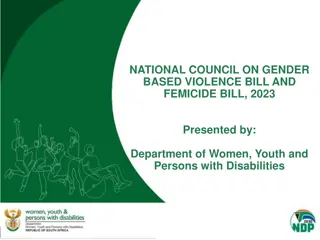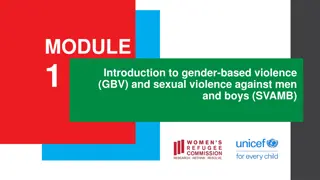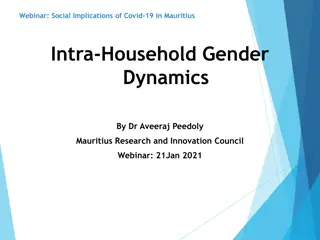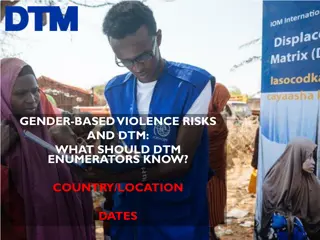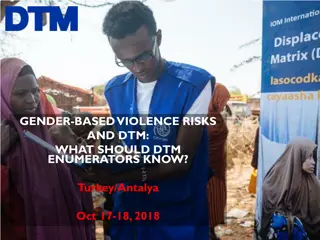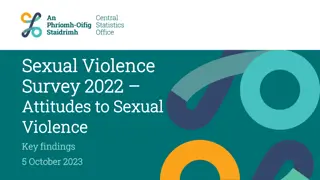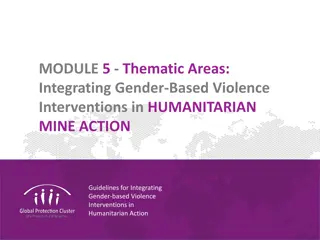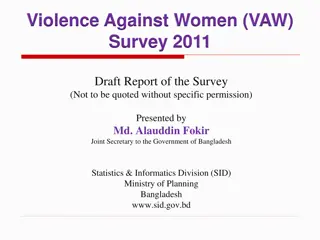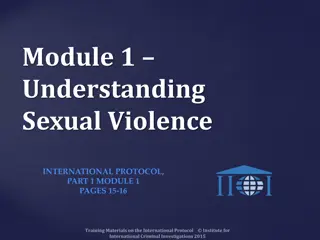Gender-Based Violence in the Metal and Engineering Industry: Research and Survey Findings
This study delves into the prevalence of gender-based violence (GBV) in the metal and engineering industry, shedding light on various forms of GBV, research methods employed, legal frameworks, work-related impacts, and survey findings. The research reveals alarming statistics and underscores the urgent need for intervention and support mechanisms to address GBV in the workplace.
Download Presentation

Please find below an Image/Link to download the presentation.
The content on the website is provided AS IS for your information and personal use only. It may not be sold, licensed, or shared on other websites without obtaining consent from the author.If you encounter any issues during the download, it is possible that the publisher has removed the file from their server.
You are allowed to download the files provided on this website for personal or commercial use, subject to the condition that they are used lawfully. All files are the property of their respective owners.
The content on the website is provided AS IS for your information and personal use only. It may not be sold, licensed, or shared on other websites without obtaining consent from the author.
E N D
Presentation Transcript
Gender-Based Violence in the Metal and Engineering Industry 21 February Prof Hoosen Rasool
GBV DEFINITION BACKGROUND Social and verbal abuse Physical attacks and fights Corporal punishment Destroying property Bullying Sexual Harassment Coercion Unwanted sexual touching Rape and attempted rape Sexual comments and jokes Gender-based discrimination
RESEARCH METHODS Literature review Conference papers, journals, seminars, periodicals, GBV publications of GBV. No publications of GBV in metal industry Interviews 17 HR Managers and 4 GBV victims in metal industry Firm Survey A 103 responses were received
BACKGROUND Employment Equity Act 55 of 1998 Maintenance Act No. 99 of 1998 Domestic Violence Act No 116 of 1998 Children s Act 38 of 2005 Criminal Law (Sexual Offences and Related Matters) Amendment Act of 2007 Code of Good Practice on the Handling of Sexual Harassment in the Workplace (2008) Protection from Harassment Act 17 of 2011 Prevention and Combating of Trafficking in Persons Act 7 of 2013
BACKGROUND Work-Related Impact 98% 96% 87% 78% 13% 78% 77% 47% 60% 45% 23% 5% Difficulty concentrating at work Affected their ability to perform job duties Received abusive phone calls at work; approximately 50 100 call p/w Abuser showed up at work Being assaulted at work by domestic abuser Being late for work due to domestic abuse Arriving late to work due to the abuser keeping them up late or all night Assaulted before going to work Losing jobs due to being fired or resignation Scared of losing their jobs if employer found out about their abuse Abuser violated protection orders by contacting victim at work Employer had a domestic violence policy in place
RECOMMENDATIONS Industry Awareness Develop an industry strategy and plan to highlight GBV and support its victims. Lobby individual firms to conduct education and awareness programmes for employees. Put GBV on the agenda for industry conferences and seminars. Develop industry-wide policy guidelines of how individual companies should address GBV. Employer bodies and trade unions should support the elimination of GBV in its constituencies through programmes.
RECOMMENDATIONS GBV Costs The industry stakeholders should start a process of calculating and costing the impact of GBV on the industry. Community Support community-based initiatives to prevent violence, including school-based programmes, to address gender norms and attitudes, and mobilising individuals and communities to challenge these social norms. Provide support to community-based NGOs that deal with GBV and that aid victims of GBV.
RECOMMENDATIONS Victim support The merSETA should develop education and training programmes on what is GBV, how it affects victims, and what assistance victims need. Companies, trade unions and employer bodies should run training programmes for employees on GBV to show how victims and abusers can seek help and learn to relate in a healthy way. Conduct specialist training for HR and the Wellness/Nursing staff to deal with GBV and sexual harassment. Provide education, training, and dialogue on how employees (both women and men) can access community-based counselling to assist their partners deal with substance abuse and addictive behaviour.
RECOMMENDATIONS Company-level Interventions Companies should develop GBV policies and procedures. GBV issues should be communicated to employees. Employees should be given training on GBV. Management should be trained to identify GBV victims and aid them. GBV victims should have access to professional counselling. Posters and information leaflets developed. GBV should be part of any EAP that the company has in place. Consider developing the Safe Circle approach. This approach has been used by companies such as Ford, Lockheed, and Rolls Royce. This approach involves management and employees meeting in small groups in order to increase communication between supervisors and workers over issues such as GBV and sexual harassment. Alternatively consider appointing a GBV representative, similar to a Health and Safety officer, who is trained in dealing with employees facing GBV. Consider getting the SAPS to regularly visit the company to explain to employees how they can use the Domestic Violence and Sexual Offenses Acts to assist victims of GBV.
BACKGROUND Abusers The company should include rehabilitation and assistance to abusers as well as conduct an awareness campaign targeting abusers that are in the employment of the company. Allow for victims to have access to affordable medical/psychological assistance.
RECOMMENDATIONS Support Emergency telephone numbers should be easily accessible to GBV victims. Details of support structures in the community, such NGOs, safe houses, and religious organisations should be accessible to GBV victims. GBV survivors should be educated on how to obtain protection orders against a violent or threatening person. GBV survivors should be educated on the psychological effects GBV can have on them and understand the importance of seeking counselling or similar assistance. GBV survivors should understand that the abuse can affect their behaviour and may result in the victims resorting to drugs and alcohol as a survival mechanism. They also need to understand that they can extend that violence to their children without realising that their actions are effects of the GBV they are facing. GBV should learn to recognise what is going on in their relationship and seek the necessary help and assistance. GBV survivors should recognise when their abusive partners blame them for the abuse and understand that this is not the truth, but rather a manipulative strategy used by perpetrators.
Prof Hoosen Rasool Thank you +27 83 786 9329 +27 11 064 1600 hoosen@frresearch.co.za hoosen@frresearch.co.za www.frresearch.co.za


